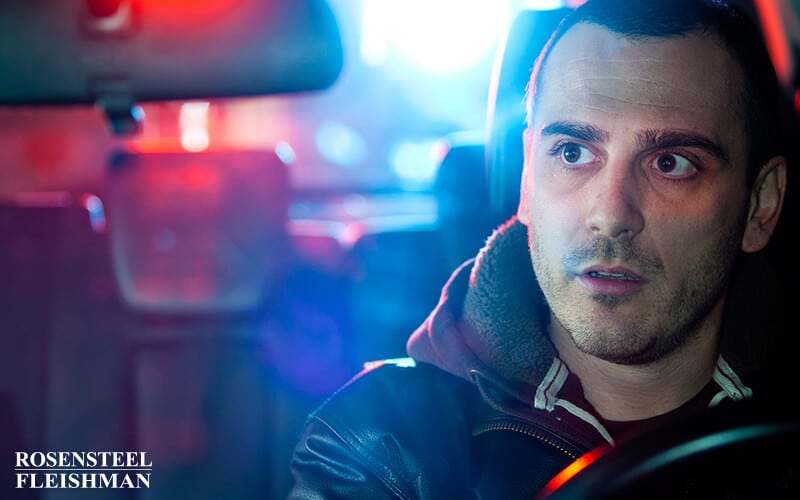While drunk driving accidents have been on the decline in the past few years, drunk driving is still a major problem in the United States and a leading cause of car accidents. The most recent statistics released by the National Highway Traffic Safety Administration show that approximately 28 people die in car accidents every day […]

Weaving as Reasonable Suspicion for DWI in North Carolina
Until recently, North Carolina courts required that weaving within your lane, by itself, is not sufficient to provide reasonable suspicion for a traffic stop, but it could contribute to reasonable suspicion under the totality of the circumstances. To provide reasonable suspicion, at least one other factor had to be present, such as driving at an unusual hour or being in the vicinity of bars. In 2012, North Carolina courts seemed to shift their analysis to allow weaving, as long as there was lots of it, to provide reasonable suspicion by itself. Let’s see how they got there.
First, we’ll start with the Fourth Amendment, which protects us against unreasonable searches and seizures. The Fourth Amendment states that
The right of the people to be secure in their persons, houses, papers, and effects, against unreasonable searches and seizures, shall not be violated, and no warrants shall issue, but upon probable cause, supported by oath or affirmation, and particularly describing the place to be searched, and the persons or things to be seized.
The US Supreme Court has held that a “traffic stop is a seizure ‘even though the purpose of the stop is limited and the resulting detention quite brief.’” Traffic stops are reviewed under the standard set out in the US Supreme Court case Terry v. Ohio, which requires an officer to have “"reasonable, articulable suspicion that criminal activity is afoot."
The North Carolina Court of Appeals summarized in the 2009 case, State v. Fields, the rationale behind the reasonable suspicion standard. “The requisite degree of suspicion must be high enough ‘to assure that an individual's reasonable expectation of privacy is not subject to arbitrary invasions solely at the unfettered discretion of officers in the field.’” The court noted that they had previously “held that weaving can contribute to a reasonable suspicion of driving while impaired.” However, courts had held that there must always be another factor present in addition to weaving. Examples of additional factors noted by the court were traveling well below the speed limit, driving off the road, speeding, driving at an unusual hour, and being in the vicinity of bars.
The court stated that
In order to preserve an individual's Fourth Amendment rights, it is of the utmost importance that we recognize that the presence of any one of these factors is not, by itself, proof of any illegal conduct and is often quite consistent with innocent travel.
Because in Fields there was no additional factor (the defendant was stopped at 4 p.m. and there was no evidence showing that there were bars in the vicinity), the court held that “[t]he totality of circumstances do not give rise to a reasonable, articulable suspicion of criminal activity justifying the stop of defendant's vehicle.”
Later in 2009, the court of appeals, followed their previous reasoning, requiring a factor in addition to weaving in State v. Peele. In that case, the officer responded to a dispatch regarding “a possible careless and reckless, D.W.I.” headed towards a nearby intersection. The dispatch was in response to an anonymous tip. The officer spotted a vehicle matching the color and make of truck, followed the truck for about a tenth of a mile, and saw the truck weave in its lane once. The court stated that all they had was “a tip with no indicia of reliability, no corroboration, and ‘conduct falling within the broad range of what can be described as normal driving behavior.’” They held that the single instance of weaving combined with the unreliable anonymous tip did not provide reasonable suspicion and stated that if they were to allow it to, they “would be, as the Court in Fields cautioned against, ‘extend[ing] the grounds for reasonable suspicion farther than our Courts ever have.’”
Then, in 2012, the court of appeals decided the case, State v. Fields (which was not related to the 2009 case of the same name). In the 2012 Fields, the officer notice the defendant’s car because he had dim taillights. The officer followed the defendant for at least ¾ of a mile, during which time he observed the defendant “weaving within his lane of travel constantly and drove on the center line at least once.” The defendant’s driving was so erratic that drivers going the opposite direction pulled over to the side of the road in response to the defendant’s driving. At about 10:30 p.m., the officer pulled over the defendant.
The court distinguished the decisions in the 2009 Fields and Peele, which required an additional factor to weaving, from the 2012 Fields facts because neither of the other cases “involved the level of erratic driving and potential danger to other drivers that was involved in this case.” Because the defendant’s weaving was so substantial, the court held that the officer had reasonable suspicion to stop him.
Later that same year, the North Carolina Supreme Court decided State v. Otto, which seemed to confirm the court of appeals reasoning in the 2012 Fields. In Otto, the officer saw the defendant’s car coming from the direction of an equestrian center where he knew there was a banquet that night. The officer didn’t know specifically where the car was coming from and didn’t know for sure that alcohol was served at the banquet. The officer happened to turn behind the defendant’s car and “immediately started noticing [it] was weaving” within its own lane, though it never left its own lane. The defendant’s car traveled at the posted speed limit of 55 m.p.h. The officer watched the defendant weave for about ¾ of a mile and then stopped the defendant.
The Court distinguished the 2009 Fields as involving only a single instance of weaving and Peele as involving only three instances of weaving over the course of a mile and a half. In contrast, the defendant in Otto “constantly and continuously” over the court of ¾ of a mile. The Court added, almost an afterthought, “[i]n addition, defendant was stopped around 11:00 p.m. on a Friday night.” However, this factor did not seem to be dispositive and the Court seemed to base its reasoning mainly on the severity of the defendant’s weaving rather than the time of night. It concluded that the officer had reasonable suspicion to stop the defendant.
Earlier this year, the court of appeals decided another weaving case, State v. Derbyshire. In that case, the officer came upon the defendant from the opposite direction and thought the defendant had his brights on. She flashed her own brights at him in an attempt to cause him to dim his. When the defendant failed to respond, the officer glanced at him when her car passed his and noted that he had a “blank stare” which she thought was an indication of a potential impaired driver. She turned around and began following the defendant, during which time she saw him weave “at least once.” She then stopped him on suspicion of dwi.
As it turned out the defendant did not have his brights on, but had “very, very bright” halogen headlights. The court distinguished the Otto decision because Derbyshire did not involve “weaving constantly and continuously over the course of three-quarters of a mile”. Because the defendant had only an instance or two of weaving, the court required that there be a factor present in addition to the weaving. The court held that “the facts that Defendant was driving at 10:05 on a Wednesday evening and that [the officer] believed Defendant's bright lights were on are not sufficiently uncommon to constitute valid “plus” factors.” The court reasoned that “[a]n increase in the likelihood that an individual may be subjected to a Terry stop merely because that person owns a car that ‘sits high off the ground’ or that was built with brighter headlights, as in this case, would constitute an irrational inference of criminal activity, which we decline to adopt here.”
If you have been charged with DWI after a traffic stop based on weaving, contact an attorney at Rosensteel Fleishman Car Accident & Injury Lawyers (704) 714-1450, to discuss your options.
Additional DWI Articles
I. You Will Need a Lawyer Just because someone has had drinks, does notautomatically mean that the law should rest on their shoulders and result in an automatic conviction. That is partly why, under North Carolina law, a series of safeguards have been adopted. These safeguards often rely on, and are helpfully followed, by experienced […]
I. Working While Impaired It is a sobering crisis. We cannot say for sure just exactly how many people drink during work hours, and then drive a vehicle within a short period of time after leaving the restaurant or bar. Often, it requires help from a car accident attorney to see if this drinking is […]
I. PC for DWI An experienced Charlotte criminal trial attorney is aware of the unique place that DWI charges can play in North Carolina courts. There’s no doubt that the public generally supports crackdowns on DWI offenses in North Carolina. But here’s the news flash: as important as DWI is, to maintaining public safety, it’s […]
